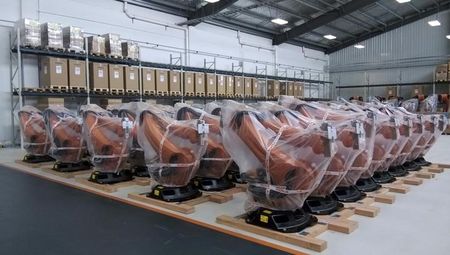
Investing.com — A rising curiosity amongst companies has resulted in main developments in humanoid robotics in current months.
Analysts at Bernstein supply a contemporary perspective on the inventory market’s reactions to the most recent developments and traits.
A subject poised on the crossroads of innovation and problem, promising to redefine industries whereas elevating crucial questions on industrial feasibility, is the topic of this evolving narrative.
As soon as the area of area of interest analysis labs, humanoid robotics is now a magnet for a few of the world’s largest corporations.
Over the previous six months, business giants reminiscent of Huawei, NVIDIA (NASDAQ:), Samsung (KS:), Toyota (NYSE:), and Foxconn (SS:) have elevated their investments on this area.
These various gamers—from expertise to shopper electronics to automotive—are positioning humanoid robots as a transformative drive throughout sectors.
As per Bernstein, this surge displays a collective understanding that humanoid robots could quickly turn into a crucial aggressive enviornment in world innovation.
This newfound enthusiasm has expanded the scope of robotics growth, with collaborations and competitors driving speedy developments.
The market is abuzz with the promise of humanoid methods that might revolutionize fields like manufacturing, healthcare, and logistics.
But, this momentum can be making a speculative surroundings, as stakeholders grapple with separating near-term capabilities from long-term potential.
On the core of the progress are breakthroughs in two key areas of robotics: the “cerebellum” and the “brain.”
The robotic cerebellum, which manages steadiness and motion, has traditionally been a big hurdle for legged robots.
Easy, coordinated movement has lengthy eluded engineers, however current demonstrations recommend a turning level. Unitree, for instance, unveiled a wheel-based four-legged robotic with extremely adaptive motion capabilities.
This innovation showcases that humanoid robotics can now transcend older constraints, providing options that merge stability, vitality effectivity, and superior coordination.
In the meantime, progress within the robotic mind—process planning and decision-making methods—stays incremental.
Nevertheless, NVIDIA’s Cosmos World Basis Fashions mark an thrilling growth.
These fashions simulate bodily environments with exceptional realism, offering robots with digital areas to pre-train earlier than real-world deployment.
This potential to switch abilities from digital to bodily environments may speed up developments not solely in humanoid robotics however in broader areas of sensible automation.
Collectively, these technological strides are narrowing the hole between aspiration and performance. Bernstein analysts emphasize that whereas challenges stay in enhancing stability and reliability, the foundations for significant innovation are firmly in place.
Regardless of this progress, the monetary impression of humanoid robotics stays speculative.
Bernstein’s evaluation highlights that the sector remains to be removed from delivering substantial income development for corporations concerned.
However, the inventory market has proven a robust event-driven response, with share costs of robotics-linked companies experiencing sharp actions following main bulletins or breakthroughs.
This volatility displays the speculative nature of the sector. Whereas traders are desperate to journey the wave of innovation, it stays unsure which corporations will emerge as long-term beneficiaries.
For now, humanoid robotics serves extra as a thematic funding alternative than a secure supply of returns.
Humanoid robots are at an intriguing juncture. On one hand, developments of their cerebellum and mind are making these machines more and more able to dealing with advanced, real-world duties.
Alternatively, questions on their scalability, cost-effectiveness, and integration into present industries persist.
Bernstein analysts stay cautiously optimistic, underscoring that the sector’s potential is as a lot about redefining what machines can do as it’s about turning these capabilities into sustainable companies.
As innovation continues to speed up, the narrative of humanoid robotics is more likely to stay a compelling mix of technological promise and market intrigue.




